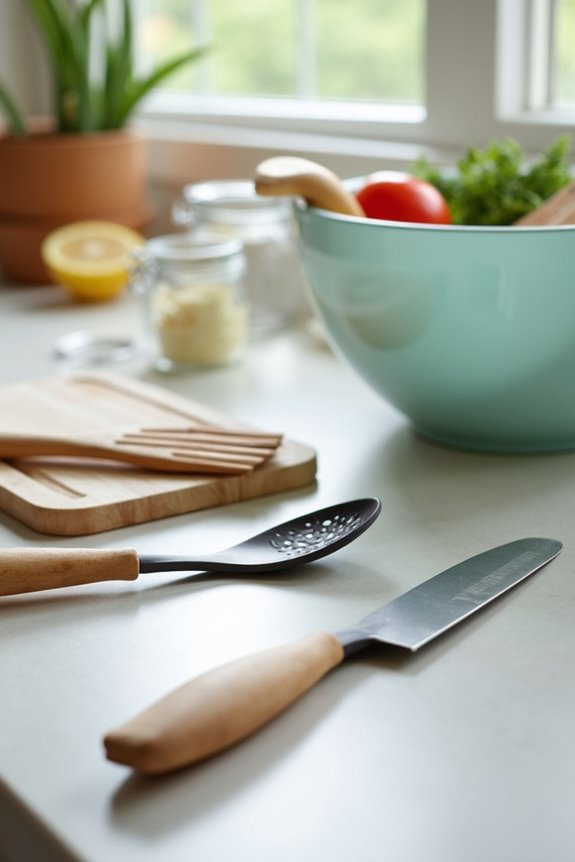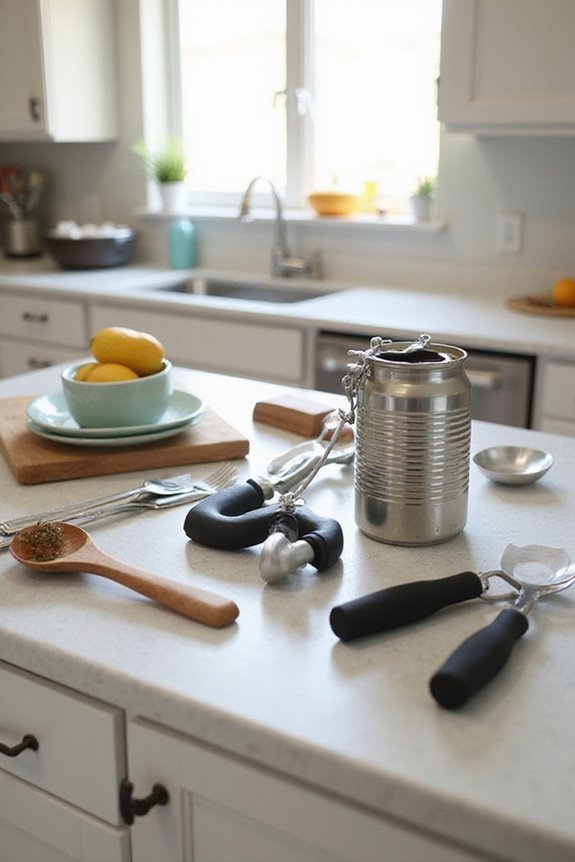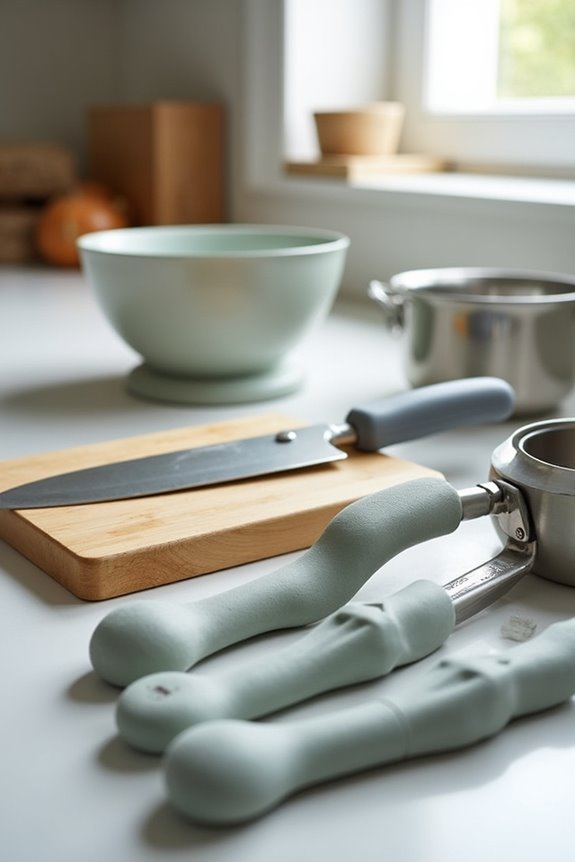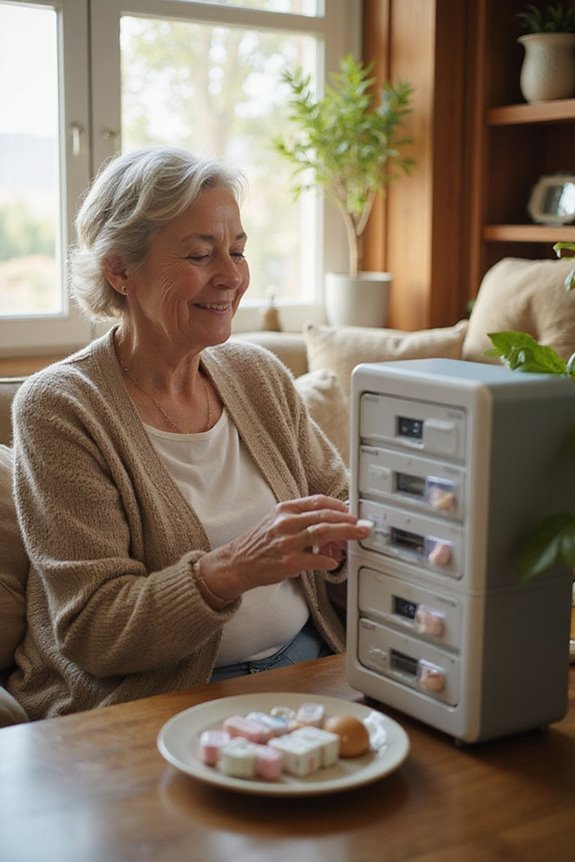Choosing the right adaptive aids for the kitchen involves several critical steps:
- Assess Individual Needs: Evaluate fine motor skills and mobility constraints.
- Identify Daily Tasks: Consider food preparation activities and cleaning challenges.
- Safety Features: Look for non-slip grips and automatic shutoff systems.
- Compatibility: Confirm tools fit with existing kitchen equipment.
- Ergonomics: Select aids that prioritize comfort and usability.
Further insights on each aspect can enhance decision-making in this area.
Key Takeaways
- Conduct individual assessments to identify specific needs, including mobility constraints and fine motor skills, for selecting suitable adaptive aids.
- Evaluate daily kitchen tasks and challenges to determine which adaptive tools can enhance safety and efficiency during food preparation and cleanup.
- Prioritize safety features, such as non-slip surfaces and automatic shutoff systems, to reduce risks while using kitchen tools and appliances.
- Ensure compatibility with existing kitchen equipment by choosing ergonomic designs that fit standard sizes and match the quality of current utensils.
- Explore modified kitchen appliances, like automatic can openers and front-control ovens, to improve accessibility and usability for individuals with disabilities.
Understanding Individual Needs and Limitations
Understanding individual needs and limitations is vital when selecting adaptive aids for the kitchen. Conducting thorough individual assessments and functional evaluations is essential in identifying specific requirements.
- Fine Motor Skills: Assess grip strength and hand dexterity to find tools with enhanced grips or modified handles.
- Reach Limitations: Evaluate range of motion to determine suitability for swivel shelves or extended handles.
- Mobility Constraints: Consider wheelchair access, requiring roll-under sinks and accessible counters.
- Balance Issues: Prioritize tools with stability features for those with coordination difficulties.
- Cognitive Considerations: Select intuitive aids that support memory and sequencing challenges.
Additionally, incorporating ergonomic design features into the selection process can significantly improve user comfort and safety. These evaluations guarantee that selected aids enhance functionality and promote independent kitchen use, fostering a sense of belonging for all users.
Identifying Daily Kitchen Tasks and Challenges

Identifying daily kitchen tasks and challenges is essential for optimizing efficiency and safety in the kitchen environment. Key activities include:
- Food Preparation and Cleanup: Average time spent is approximately 0.65 hours daily.
- Interior Cleaning Tasks: Involves wiping surfaces and organizing.
- Managing Dishware: Regular washing and sanitizing are necessary.
- Kitchen Organization: Vital for maintaining task efficiency and reducing clutter.
- Floor Maintenance: Sweeping and mopping are daily necessities.
Recognizing these tasks aids in prioritizing cleaning schedules, which support kitchen cleanliness. Additionally, addressing challenges such as cross-contamination risks and accessibility issues can enhance overall safety. By understanding daily demands, individuals can effectively allocate time, ensuring a well-maintained kitchen that fosters productivity and minimizes hazards. Using adaptive utensils can further promote independence and comfort during mealtime tasks.
Evaluating Safety Features in Adaptive Tools

How can safety features in adaptive tools enhance kitchen usability for individuals with varying needs? Evaluating these features is essential for ensuring a safe cooking environment.
Non-Slip Surfaces
- Non-slip handles and utensils minimize the risk of dropping, enhancing stability.
- Non-slip mats and suction feet secure items, preventing accidental movement.
Safety Locks
- Safety locks on knives and food processors prevent unintended activation.
- Automatic shutoff systems on stoves detect inactivity, reducing fire hazards.
Ergonomic Design
- Ergonomically designed tools reduce strain, facilitating safer handling.
- Stabilizing handles improve control during food preparation. Additionally, ergonomic design features ensure that tools accommodate various grip strengths for enhanced usability.
Compatibility With Existing Kitchen Equipment

When selecting adaptive aids, one critical consideration is their compatibility with existing kitchen equipment. This guarantees seamless integration into the kitchen environment.
Adaptive Utensil Compatibility
- Choose ergonomic designs that complement standard utensils.
- Confirm tools fit standardized sizes for easy storage.
- Opt for durable materials that match the quality of current utensils.
Appliance Integration Solutions
- Verify that adaptive aids are compatible with existing electrical outlets and appliances.
- Select tools that fit alongside existing devices without obstructing functionality.
- Consider aids with flexible mounting options for various setups. Additionally, user accessibility features are essential for ensuring that adaptive aids are user-friendly for individuals with varying physical abilities.
Exploring Modified Kitchen Appliances

Exploring modified kitchen appliances reveals a range of options designed to enhance accessibility and efficiency in food preparation. Adaptive technology has led to significant appliance innovation, making daily tasks easier for users with varying abilities.
- Automatic can openers reduce manual effort for individuals with limited hand strength.
- Side-by-side refrigerators provide improved access for wheelchair users.
- Front-control ovens enhance safety by eliminating the need to reach over hot surfaces.
- Smart appliances with voice control allow for hands-free operation, benefiting those with mobility impairments. Additionally, the incorporation of ergonomic kitchen tools can further optimize comfort and usability during meal preparation.
These modified appliances not only increase independence but also foster a sense of belonging in the kitchen, allowing all individuals to engage in cooking and meal preparation comfortably and confidently.
Assessing Ergonomic Design and Usability
Evaluating ergonomic design and usability in adaptive kitchen aids is essential for optimizing the cooking environment for users with varying abilities. Key factors to take into account include:
- Ergonomic Assessments: Prioritize tools that minimize reaching, bending, or twisting, especially for users with limited mobility.
- Usability Testing: Assess the ease of use of items with contoured handles, adjustable height options, and single-handed operation capabilities.
- Safety Features: Verify tools have non-slip surfaces, stable bases, and blunt edges to reduce injury risk.
- Adaptability: Select aids that facilitate multiple kitchen tasks, improving overall workflow efficiency.
Researching Brands and Customer Support Options
Researching brands and customer support options is vital for selecting adaptive kitchen aids that meet user needs. Brand evaluations should prioritize manufacturers like Conair Corporation, Oxo, and trusted medical companies such as North Coast Medical. These brands typically provide specialized tools with a focus on accessibility.
Effective support channels are important for user satisfaction. Look for companies offering 24/7 chat and phone assistance, thorough instructional materials, and easy access to replacement parts. Transparent warranty and return policies enhance trust, particularly with trial periods and clear defect coverage.
Lastly, brands that engage with customers through newsletters and updates demonstrate commitment to ongoing support. Evaluating these factors guarantees informed decisions and fosters a sense of community for users steering through their adaptive kitchen needs.
Frequently Asked Questions
How Can I Test Adaptive Aids Before Purchasing Them?
A study revealed that 70% of users benefited from adaptive aid trials before purchase. Testing aids firsthand allows potential buyers to gather valuable user feedback, ensuring comfort and efficiency in meeting individual needs and enhancing everyday experiences.
Are There Financial Assistance Programs for Adaptive Kitchen Tools?
Financial assistance programs exist for adaptive kitchen tools, offering financial aid through various adaptive grants. These resources support individuals with disabilities, ensuring they can access necessary equipment, fostering independence and enhancing their quality of life.
What Materials Are Best for Adaptive Utensils and Tools?
In the domain of adaptive utensils, silicone’s gentle embrace contrasts with the steadfast strength of stainless steel tools, creating a harmonious blend that invites users to navigate culinary tasks with confidence and comfort, fostering a sense of belonging.
Can Adaptive Aids Be Personalized for Specific User Needs?
Adaptive aids can indeed be personalized to meet specific user needs, offering customized solutions that accommodate individual preferences. This personalization fosters a sense of belonging, enhancing comfort and usability for diverse users in various situations.
How Do I Maintain and Clean Adaptive Kitchen Devices?
Maintaining and managing adaptive kitchen devices requires diligent cleaning techniques and thoughtful maintenance tips. Regular inspections, thorough cleaning, and prompt repairs guarantee safety and functionality, fostering independence and enhancing the overall kitchen experience for users.





